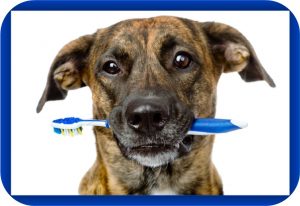Your Dog’s Teeth
Taking care of your dog’s teeth—especially if your dog is older—is much more important than most of us would think.
When I asked Old Dog Haven’s Executive Director Judith Piper to talk about ODH dogs and dental problems she said:
“Many, many of the dogs ODH takes in have badly neglected mouths. Dental procedures often are the most expensive part of our intake medical work (“deferred maintenance” as we call it) because the damage in these dogs’ mouths is so extensive. It would be so much better for the dog to have had dental work done when he was younger and stronger! Fixing neglected mouths can be a real challenge by the time the dog is elderly. Anesthesia is always more of a risk then and some old dogs just can’t recover from it well. Beyond that, if there has been extensive decay it often has damaged the jaw bones themselves, making the dental procedure extremely challenging and often requiring a dental specialist. (Very expensive, not quickly available and not available at all in many areas). We have to really balance the pain that diseased teeth may be causing the dog against the risk for an old dog, which is not an easy decision.
“Some breeds are particularly prone to dental problems; we find that dachshunds are often the worst, but tiny dogs like poodles and yorkies can be extremely challenging as well. Tiny dogs with diseased canine teeth may have oronasal fistulas (openings into the nasal cavity) or the roots may take up so much of the lower jaw bone that extraction is extremely difficult without causing a fracture. Both conditions require a very skilled dentist. Even the larger dogs can suffer a tooth root abscess so severe that it makes a hole (draining tract) in the face. What a lot of pain for the poor dog—and so much more easily fixed when the tooth first became diseased.”
The four dogs shown at the end of the blog are ODH dogs (L-R) Christine, Duke, Lucky Charm and Wookie. Almost all of their teeth needed to be removed because they were rotten and infected.
Here’s an article written by Dr. Marty Becker with some interesting information about canine dental health that you might find helpful:
5 Dog Dental Health Myths Debunked
By Dr. Marty Becker DVM
You see your dog’s teeth every day, but how much do you really know about them? A dog’s fangs are the gateway to the digestive system, and they are an important part of his ability to lead a happy life. After all, how is he going to enjoy delicious treats or chow down at meals if he doesn’t have healthy teeth?
Your dog’s mouth can tell you a lot about his health, but there are a number of myths and misconceptions out there about dog dental care. I talked with my colleague Dr. Laura LeVan, a veterinary dental specialist, to find out what information is true and what bites.
True or False?
1. It’s normal for dogs to have bad breath.
Absolutely not! Your dog shouldn’t have bad breath any more than you should. “Bad breath isn’t always coming from the oral cavity,” Dr. LeVan says. “It can be coming from any part of the upper digestive tract, and it is not normal.” If your dog does have bad breath, take him to the veterinarian for a checkup and schedule a professional cleaning or other recommended treatment to help manage the problem.
2. Dogs can clean their teeth themselves by gnawing on dental chews or toys, raw bones and antlers.
Also false. Bones and antlers are hard and can break the teeth of dogs that are vigorous chewers—and they can get caught in the dog’s mouth and cause injuries. And while certain chew toys can provide limited dental health benefits—such as rope bones, which may have a sort of flossing effect, and nubbly chews, which can help to stimulate the gums—chewing alone doesn’t keep teeth and gums healthy.
3. Dry food helps to keep a dog’s teeth clean.
True—but with some reservations. There’s a long-standing belief that dry food is better than canned food for dental health because it helps to scrape off tartar. “There is some truth to that,” Dr. LeVan says. “There is a variety of opinion, but anything that’s a little bit abrasive does help to keep plaque and calculus off teeth.” That doesn’t mean, though, that your dog should get only dry food. Lots of factors play into the choices we make for pet foods, and each type of food has pros and cons. Dogs are individuals, and what works well for one may not be the best choice for another. Talk with your veterinarian about your dog’s diet—and his dental health.
4. A dog’s mouth is cleaner than a human mouth.
Legends about the healing powers of a dog’s lick notwithstanding, this myth is just not true. “The fact of the matter is, dogs and humans all have bacteria in their mouths,” De. LeVan says. “Dogs have a different population of bacteria, but that doesn’t make their mouths cleaner.” Some dogs love to lick their people, but avoid letting your dog lick open sores or cuts on your body—and if a dog bites you, clean the wound thoroughly with soap and water.
5. Nothing can be done to prevent dog dental disease.
The good news is that this myth is untrue as well. The most cost-effective thing you as a pet owner can do to help prevent or slow the progression of periodontal disease is to brush your dog’s teeth daily to help remove plaque and prevent tartar buildup. “It is the gold standard for preventive care,” Dr. LeVan says.



